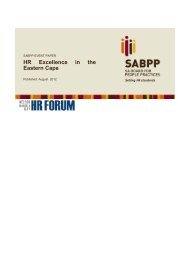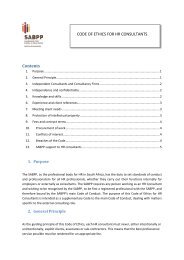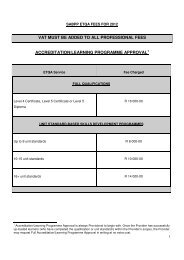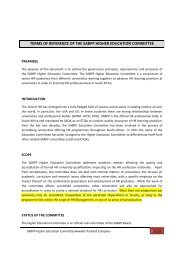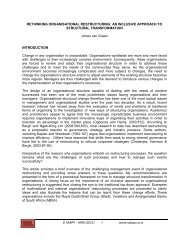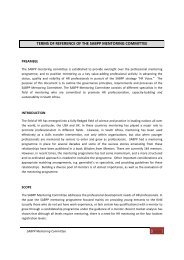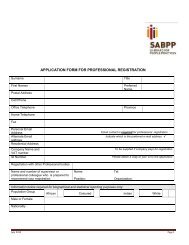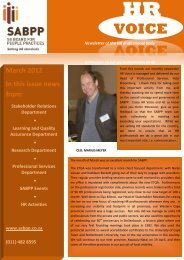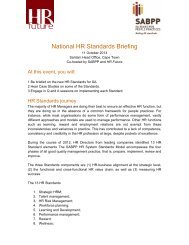1 © SABPP â HRRI (2011) | www.sabpp.co.za LEARNING ...
1 © SABPP â HRRI (2011) | www.sabpp.co.za LEARNING ...
1 © SABPP â HRRI (2011) | www.sabpp.co.za LEARNING ...
Create successful ePaper yourself
Turn your PDF publications into a flip-book with our unique Google optimized e-Paper software.
Table 1: The five disciplines as originated by Senge1990The fiveDescriptionsdisciplinesPersonal Personal Mastery involves individuals being more realistic about whom they really areMastery and focused on be<strong>co</strong>ming the best person possible and to strive for a sense of<strong>co</strong>mmitment and excitement in their careers. Individuals learn to expand their ownpersonal capacity to create the results they desire.Mental Mental models are deeply ingrained assumptions, generalisation or picture images thatmodels influence how people understand the world and the action they take. This involves eachindividual reflecting upon, <strong>co</strong>ntinually clarifying and improving their picture image of theworld and seeing how they shape personal actions and decisions.Shared A shared vision is a picture of the future which is shared by all. It involves individualsvision building a sense of <strong>co</strong>mmitment within particular workgroups, developing shared imagesof <strong>co</strong>mmon and desirable futures, and principles and guiding practices to support thejourney to such a future.Team Team learning is a process of developing the ability to create desired results, to have aLearning goal in mind and work together as a team to achieve it. It involves relevant thinking skillsthat enable groups of people to develop intelligence and an ability that is greater thanthe sum of individual members.System System thinking is the discipline that is at the heart of the learning organisation. Itthinking integrates all others disciplines and <strong>co</strong>mpels everyone in the organisation to see theiractions as inter<strong>co</strong>nnected and as part of the organisation in terms of its structures,processes, thinking and behaviours.Ac<strong>co</strong>rding to Cors (2003:4) Senge suggests that that people put aside their old ways of thinking(mental models), learn to be open with others (personal mastery), understand how their <strong>co</strong>mpanyreally works (systems thinking), form a plan everyone can agree on (shared vision), and then worktogether to achieve that vision (team learning). In many organisations learning does take placethrough day to day interactions, however this learning takes place randomly and tends to be learningfor the sake of learning. The learning organisation approach <strong>co</strong>mpels organisation to make adeliberate effort to learn, and to learn at individual, team and organisational level whilst alsomaintaining focus on the impact of the learning that has taken place, in order to achieve positive anddesired out<strong>co</strong>mes.5 © <strong>SABPP</strong> – <strong>HRRI</strong> (<strong>2011</strong>) | <strong>www</strong>.<strong>sabpp</strong>.<strong>co</strong>.<strong>za</strong>




